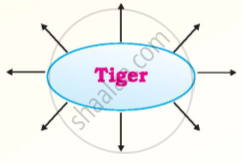Advertisements
Chapters
1.2: A Burglary Attempt
1.3: Can You Know People You Haven't Met
2.1: The Final Flight
2.2: The Sound of the Shell
2.3: Ordeal in the Ocean
3.1: The Indian Rhinoceros
3.2: Save Mother Earth
▶ 3.3: Save the Tiger
4.1: Radio Show
Chapter 4.2: Video Show
5.1: Bermuda Triangle
5.2: The Invisible Man
5.3: The Tragedy of Birlstone
5.4: Harry Potter
6.1: Tom Sawyer
6.2: Children of India
6.3: Children of Computer
6.4: Life Skills
6.5: We are the World
7.1: Grandmaster Koneru Humpy Queen of 64 Squares
7.2: It's Sports Day
7.3: Hockey and Foodball

Advertisements
Solutions for Chapter 3.3: Save the Tiger
Below listed, you can find solutions for Chapter 3.3 of CBSE CBSE for English Communicative - Main Course Book Interact in English Class 9.
CBSE solutions for English Communicative - Main Course Book Interact in English Class 9 3.3 Save the Tiger Exercise [Pages 63 - 69]
What is your opinion about 'Animals behind bars'? Share your views with the class.
Read through the poem and quickly make a note of any thoughts that come to you, while you are reading it.
Dispute
A man and a tiger once had a dispute,
Which was reckoned greater, the man or the brute.
The tiger discoursed on his side at some length,
And greatly enlarged on his courage and strength,
Said the man, 'Don't be prating; look yonder, I pray,
At that sculpture of marble: now what will you say?
The tiger is vanquished; but as for the man,
He is striding upon him: deny if you can.'
'But pray,' said the tiger, 'Who sculptured that stone?
'One of us,' said the man. 'I must candidly own.'
'But when we are sculptors,' the other replied,
'You will then on the man see the tiger astride.'
Anonymous
Answer the following question by ticking the correct option :
What was the cause of the dispute between the tiger and the man?
to establish who was superior.
to prove beasts were inferior
to justify that beasts should be caged.
to prove that man was more intelligent.
Answer the following question by ticking the correct option :
What did the man do to prove his point?
he caged the tiger.
he carved a statue of a man riding a tiger.
he put the tiger in a cage.
he enslaved the tiger.
Answer the following question by ticking the correct option :
What was the tiger's counter-argument?
he said that he was the king of the jungle.
he claimed he ruled the world.
he said the situation would be reversed if he was the sculptor.
he threatened to devour the man in a moment
In pairs discuss the qualities and characteristics of the tiger and man. Complete the web charts. 

Working in groups of four, write a dialogue between
• A tiger behind bars and a man
• A man in a cage and a tiger.
Listen to the extract on Tigers read by teacher/ student which is given below , and as you listen, complete the summary given below.
Save Tigers
The price of human greed is being paid by yet another animal species the Tiger. Today the tiger population is getting depleted at an alarming rate. According to a recent survey, one tiger is being poached everyday. If the present state of affairs is allowed to continue, the next generation will not get to see the majestic animal even in the zoo.
It is high time that action is taken to protect and conserve the tigers in order to maintain the ecological balance. Stringent laws against poachers must be enforced. It is over 40 years since the tigers became our national animal. As a result, the species was to be protected. Ironically, they are closer to extinction now than ever before. Children, scientists, conservationists, NGOs and institutions in India and world wide have put their heart and soul into trying to save the tiger. Yet there is little we all have been able to do. The responsibility and the power of protection lies with the government, specifically the forest department.
Let us not forget that if we destroy nature, ultimately we will be destroyed ourselves.
Tiger, an apex predator is an indicator of our ecosystem's health. Saving the tiger means we save the forest, since tiger cannot live in places where trees have vanished, and in turn secure food and water for all.
Tigers are now an endangered species. Today there are about 5000 to 7,400 left in the world. Three types of tigers - The Bali, Javan and Caspian tigers have become extinct. The two reasons why tigers are endangered are: Habitat loss and illegal killing.
Illegal Killing
One of the most concerning threat to our national animal that needs to be recognised is poaching. Tigers are killed to make rugs and coats out of their skins.
In many Asian cultures medicines made from tiger's body organs are believed to cure diseases.
Habitat Loss
Forests where tigers live are cut by humans for farming, building houses and roads. This leads to tigers becoming homeless and without any food. Since other animals also die when forests are cut, it leads to tigers becoming weak and their ultimate death.
Project Tiger
Project Tiger is a wildlife conservation project initiated in India in 1972 to protect the Bengal Tigers. It was launched on April 1, 1973 and has become one of the most successful wild life conservation ventures. The project aims at Tiger conservation in specially constituted Tiger reserves representative of various bio geographical regions through out India. It strives to maintain a viable conservation based on tiger population in their natural environment.
Project Tiger was Indira Gandhi's pet project. The main achievements of this project are excellent recovery of the habitat and consequent increase in the tiger population in the reserve areas, from a mere 268 in 7 reserves in 1972 to above one thousand in 28 reserves in 2006.
Tigers being at the apex of the food chain can be considered as the indicator of the integrity of the ecosystem. They can be found in a wide range of habitats, from the evergreen and monsoon forests of the Inda-Malayan realm to the mixed coniferous - deciduous woodlands of the Far east Russia and the mangrove swamps of the Sundarbans, shared by India and Bangladesh.
Tigers are mostly nocturnal but in the northern part of its range, the Siberian subspecies may also be active during the day at winter-time. All wild tigers live in Asia, others live in the humid jungles of Sumatra. The body length is 140 - 280 cm and the tail length is 60 to 95 cm. The upper part of the animal ranges from reddish orange to ochre and the under parts all whitish. The body has a series of black stripes of black to dark grey colour.
Fill in the blanks :
1. The next generation is not likely to see the tiger because of _________________________
2. ________________ laws against poachers must be enforced.
3. The responsibility of protection of the tiger lies with the ___________________
4. One of the reasons for Tiger becoming extinct is _______________
5. Destroying nature means ________________
6. ___________________ , ________________ ,and _______________ are different types of tigers.
7. ______________ is a wild life conservation project.
8. Tigers are found in the evergreen and monsoon forests of the ______________
9. Though tigers are mostly nocturnal, __________ species may also be active during the day.
10. The body length of the tiger is _______________ cm.
Read the information given below.
Do you know that tigers are the biggest cats in the world? There are five different kinds or sub-species of tigers alive in the world today. Tigers are called Panthera tigris in Latin, Bagh in Hindi & Bengali, Kaduva in Malayalam & Pedda Puli in Telugu.
Total Population of Tigers in the world
| SUB SPECIES | COUNTRIES | ESTIMATED Minimum |
POPULATION Maximum |
| P.t. altaica | China | 12 | 20 |
| Amur Siberian, | N. Korea | 10 | 10 |
| Manchurian | Russia | 415 | 476 |
| N .E. China Tiger | |||
| TOTAL | 437 | 506 | |
| Royal BengalTiger | Bangladesh | 300 | 460 |
| P.t. tigris | Bhutan | 80 | 460 |
| China | 30 | 35 | |
| India | 2500 | 3800 | |
| Nepal | 150 | 250 | |
| TOTAL | 3060 | 5005 |
| P.t. corbetti | Cambodia | 100 | 200 |
| (Inda-Chinese Tiger) | China | 30 | 40 |
| Laos | |||
| Malaysia | 600 | 650 | |
| Myanmar | |||
| Thailand | 250 | 600 | |
| Vietnam | 200 | 300 | |
| TOTAL | 1180 | 1790 | |
| P.t. sumatrae | Sumatra | 400 | 500 |
| (Sumatran Tiger) | |||
| TOTAL | 400 | 500 | |
| P. t. amoyensis | China | 20 | 30 |
| (South China Tiger) | |||
| TOTAL | 20 | 30 | |
| GRAND TOTAL | 5097 | 7831 |
Extinct Species
P.t. virgata (Caspian Tiger)
P. t. sondaica (Javan Tiger )
P. t. balica (Bali Tiger)
Tiger in Trouble
Since some tiger parts are used in traditional medicine, the tiger is in danger. Apart from its head being used as a trophy to decorate walls, tigers are also hunted for the following.
Head : As a trophy on the wall.
Brain: To cure laziness and pimples.
Teeth: For rabies, asthma and sores.
Blood: For strengthening the constitution and will power.
Fat: For vomiting, dog bites, bleeding haemorrhoids and scalp ailments in children.
Skin: To treat mental illness and to make fur coats.
Whiskers: For toothache.
After reading the information given in Question 8, complete the table given below by filling in the blank spaces.
| Sub species | Countries | Estimated Population | |
| Minimum | Maximum | ||
| P .t. altaica Amur | (a)…………………………………………….. | (b)……… | (c)……… |
| Royal Bengal Tiger | India | (d)……… | (e)……… |
| P. t. corbetti (IndoChinese tiger) |
China | (f)………… | 40 |
| P. t. sumatrae (Sumatran Tiger) |
(g)…………………………………. | 400 | (h)………… |
Massive poaching in the past two years has wiped out the entire tiger population at one of the tiger reserves in India,' claims an investigation report.
Study the information in 7 and 8 and notice how the number of tigers are falling. Using the information, write a paragraph in about 150 words on Project Tiger.
Solutions for 3.3: Save the Tiger

CBSE solutions for English Communicative - Main Course Book Interact in English Class 9 chapter 3.3 - Save the Tiger
Shaalaa.com has the CBSE Mathematics English Communicative - Main Course Book Interact in English Class 9 CBSE solutions in a manner that help students grasp basic concepts better and faster. The detailed, step-by-step solutions will help you understand the concepts better and clarify any confusion. CBSE solutions for Mathematics English Communicative - Main Course Book Interact in English Class 9 CBSE 3.3 (Save the Tiger) include all questions with answers and detailed explanations. This will clear students' doubts about questions and improve their application skills while preparing for board exams.
Further, we at Shaalaa.com provide such solutions so students can prepare for written exams. CBSE textbook solutions can be a core help for self-study and provide excellent self-help guidance for students.
Concepts covered in English Communicative - Main Course Book Interact in English Class 9 chapter 3.3 Save the Tiger are Reading, Writing and Grammar, Literature Textbook and Extended Reading Text.
Using CBSE English Communicative - Main Course Book Interact in English Class 9 solutions Save the Tiger exercise by students is an easy way to prepare for the exams, as they involve solutions arranged chapter-wise and also page-wise. The questions involved in CBSE Solutions are essential questions that can be asked in the final exam. Maximum CBSE English Communicative - Main Course Book Interact in English Class 9 students prefer CBSE Textbook Solutions to score more in exams.
Get the free view of Chapter 3.3, Save the Tiger English Communicative - Main Course Book Interact in English Class 9 additional questions for Mathematics English Communicative - Main Course Book Interact in English Class 9 CBSE, and you can use Shaalaa.com to keep it handy for your exam preparation.
